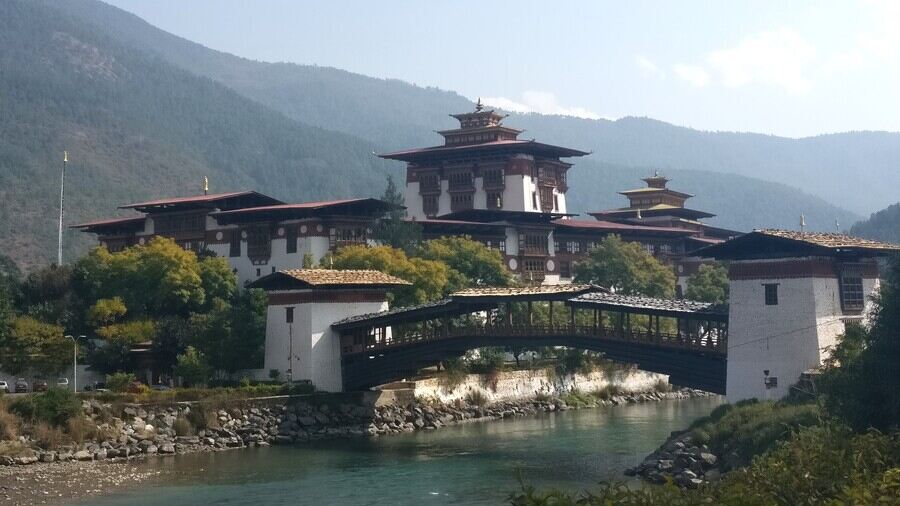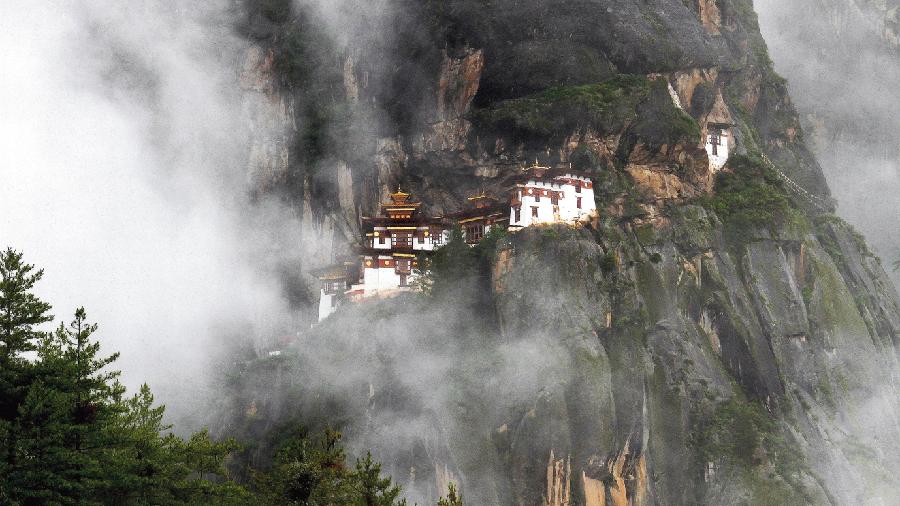Pine clad mountains, low hanging clouds blanketing deep valleys, fluttering prayer flags, green meadows and apple orchards that remind me of Switzerland. I am in remote Bumthang (meaning beautiful field) in central Bhutan. Dotted with some of the country’s oldest temples, monasteries and fortresses, Bumthang is the religious and cultural heartland of Bhutan. Known for its dairy, honey and fruit spirits, and brandies, Bumthang is swathed in buckwheat and potato fields, and has four glacier carved valleys — Ura, Chumey, Tang, and Chokhor — each with their distinct culture. “It’s the favourite posting for civil servants in Bhutan as it has the maximum number of religious holidays,” says my local guide Sithup, with a smile.
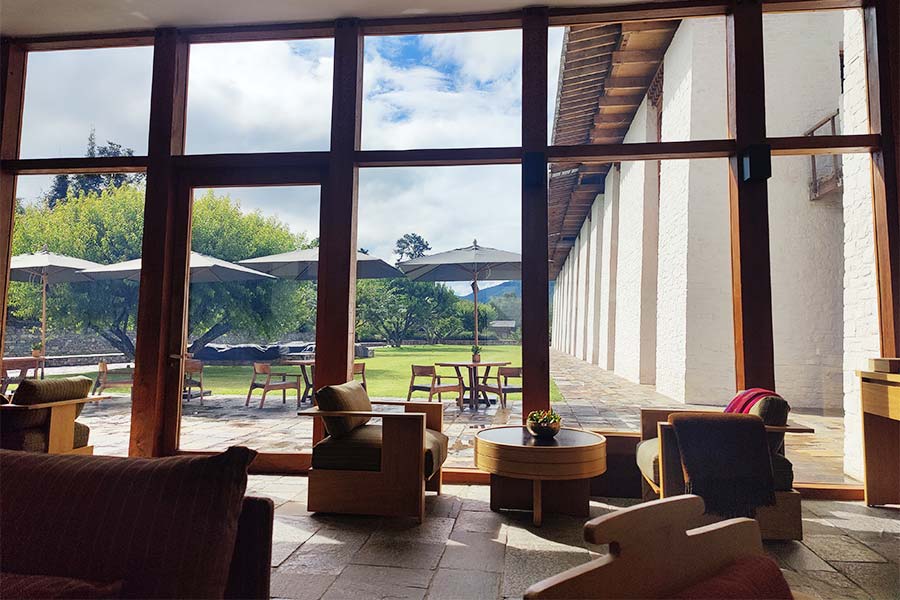
Luxury lodge Amankora offers gorgeous mountain and valley views
I arrive at the luxurious Amankora, an Aman resort in Bumthang’s Jakar town after a long drive. With sixteen suites with king beds and wood burning hearths, this lodge takes its design cues from traditional Bhutanese architecture and is done up in minimalistic aesthetics and muted palettes. Situated right by the Wangdicholing Palace, the home of the first two kings of Bhutan, it opens to views of the mountains. I unwind with a relaxing holistic massage at their spa after the long drive here, and have a delicious Bhutanese dinner with red rice, cheesy ema datshi with chillies, local noodles and hot Apple cider.
History and legends

The Jakar Dzong offers a panoramic view of the Chamkar Valley
History, legends and stories of the past whisper from every corner of the Bumthang valley. Many sites here are associated with Guru Rinpoche — the patron saint of Bhutan who is said to have arrived from Tibet atop a flying tiger and is credited for introducing Buddhism to the land. It is said that he visited Bumthang to deal with a troublesome deity, and legend has it that he hid many Buddhist teachings to be discovered by the faithful in the future. It is also the birthplace of the legendary saint Pema Lingpa, to whom the Bhutanese royalty trace their lineage.
The Jakar Dzong, like many of the dzongs — fortified monasteries that are found throughout the country — sits on a ridge, and is the first place we visit in the valley. It is accessed by a steep path lined by flowering plants and coniferous trees, and offers a panoramic sweep of the Chamkar Valley below. It is called the Castle of the White Bird, because when choosing a location for the dzong, the founders spotted a white bird perching on the mountaintop, and were convinced it was a good omen.

Like many other 'dzongs' of Bhutan, the Jakar Dzong also houses local administrative offices
Estimated to be built as a monastery in 1549 by Tibetan lama Nagi Wangchuk, it is also used partly as an administrative office — like many other big dzongs in Bhutan. We walk through a maze of walled passageways, towers and tranquil courtyards with intricate paintings and decorations, as claret-clad monks of all ages walk through the corridors, some carrying provisions and supplies. I chat with young monks who look curiously at me, and giggle as I take photographs of them going to their class.

Lamas young and old go about their day inside Jakar Dzong
A spiritual land
We drive through vast fields of sunflowers and buckwheat to Jambay Lhakhang (or Jampey Lhakhang), which is one of the 108 temples built by King Songtsen Gampo of Tibet in 659AD throughout the Himalayas. Often credited to be the first king to bring Buddhism to the Tibetan people, legend has it that the king built all these temples to subdue a female ogre and pin her to the ground. Senior citizens of all ages bundled in woollens, walk slowly around the temple, as they turn the prayer wheel. “They not only pray and meditate, it also is good exercise for them,” says Sithup.
Inside the temple, surrounded by the fragrance of butter lamps, sits a statue of Jampa, the Buddha of the future, with his feet on an elephant. Inside the inner sanctum, is a chapel lined with ancient murals or thangkas depicting 1,000 Buddhas, where visitors sit quietly meditating.
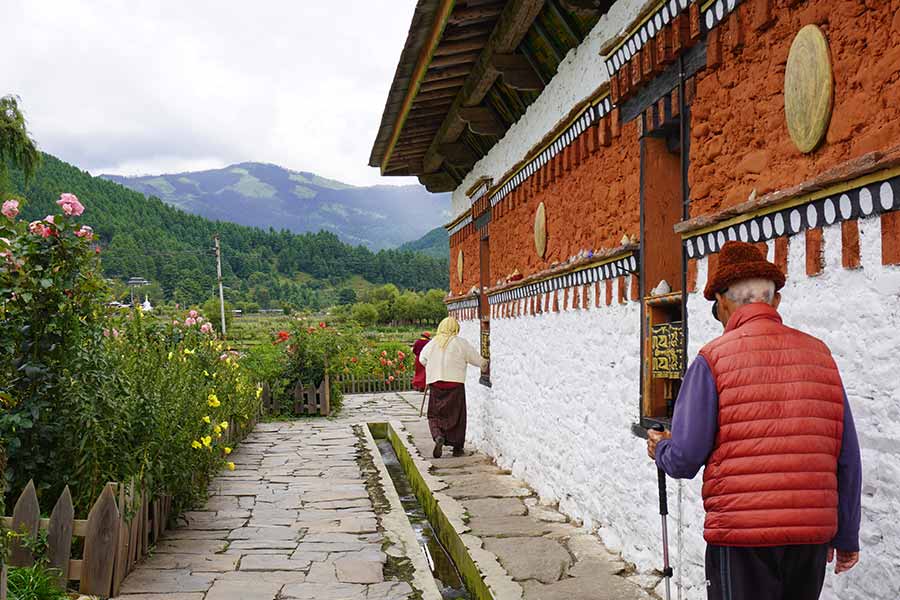
Senior devotees circumambulating Jambay Lhakhang
This is also the venue of the annual Naked Dance, part of the Jambay Lhakhang Drup Festival held in the early winter months between late October and mid November. “At the stroke of midnight, 16 naked men dance galloping in the air, accompanied by the music of drums and cymbals, their faces covered with masks,” explains Sithup, adding that “obviously no photography is allowed.” The story goes that demons delayed the construction of a monastery by destroying it every night, thus, Terton Dorje Lingpa — known for establishing many religious dances — started the Naked Dance to distract the demons.
The most picturesque of all the sites is Kurjey Lhakhang, one of the most sacred and holy sites of Bhutan. Kurjey translates to ‘the body imprint’ — in this case, the imprint of Guru Rinpoche. Situated on a hilltop, the whole complex is enclosed by 108 small stupas, along with a huge cypress tree, believed to have grown out of Rinpoche’s walking stick.
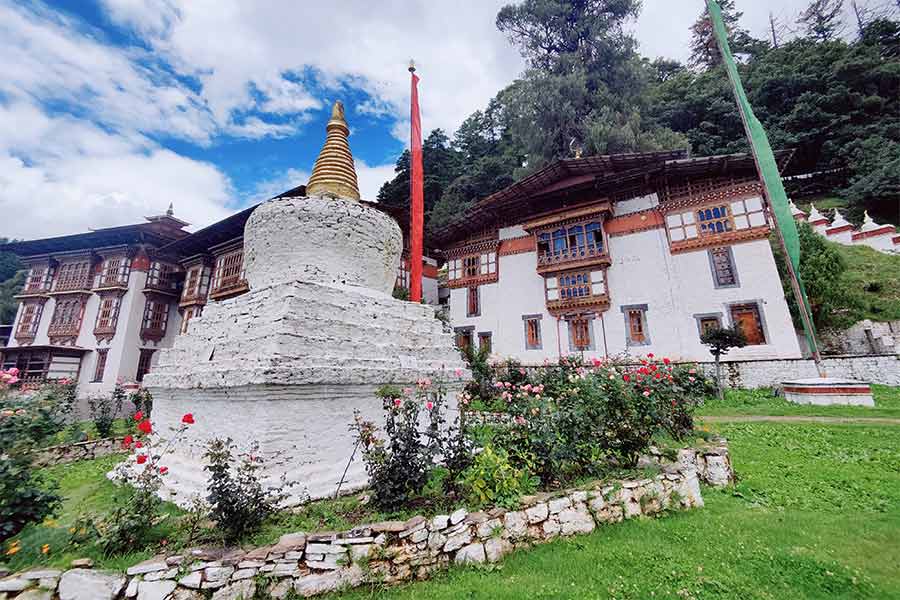
One of Bhutan's most sacred sites, the Kurjey Lhakhang is also Bumthang's most picturesque
I am slightly breathless climbing a steep flight of stairs in these high altitudes to reach the cave where Rinpoche meditated and left his body imprint. The temple was built around this, and over the centuries, more temples were added. The main statue in this sanctuary is of Guru Rinpoche, flanked by his eight manifestations and eight chortens.
My favourite temple is tranquil Tamzhing or Tamshing Lhakhang, also known as the Tamzhing Lhündrup Monastery, which houses one of the oldest statues of Rinpoche built by the saint Pema Lingpa. It has ancient thangkas and a heavy iron net supposed to have been made and blessed by Pema Lingpa. Locals believe that their sins will wash away if they carry the iron net and circumambulate the temple three times.
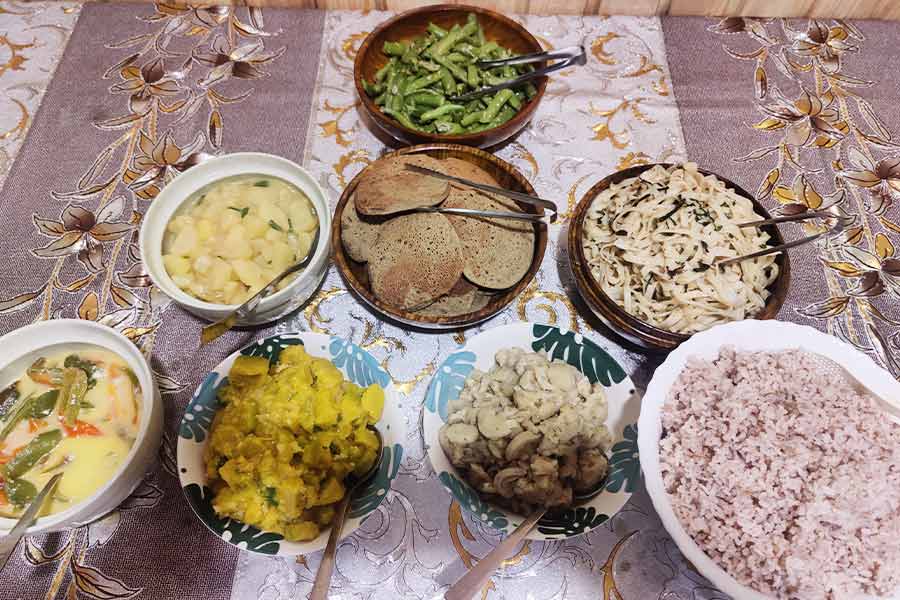
A farmhouse lunch of 'ema datshi', buckwheat pancakes and flat noodles called 'jambuli', near Tamshing Lhakhang
Not far from the temple, we have a delightful lunch at a farmhouse, where a mother-daughter duo cook and serve us local specialities like the national dish of datshi cheese and chillies ema datshi, buckwheat pancakes and flat noodles called jambuli, served with the local fiery ara or arak — a clear or creamy local alcohol distilled from rice or millets. The food feast continues at Amankora with Chef Tshering Phuntsho serving us some unique recipes from eastern Bhutan at dinner, including a roasted wheat flour soup and a piquant mountain radish curry.
Beyond the spiritual path
Not everything in Bumthang is about religion though. There are several pretty trails and hiking routes for those who like adventure. A popular route is the Bumthang Owl Trek — a three-day journey that takes you through ancient forests, high mountain passes, and traditional villages. Bumthang is also home to two national parks with Alpine meadows, which shelter rare species like the Himalayan black bear, snow leopards and wolves.
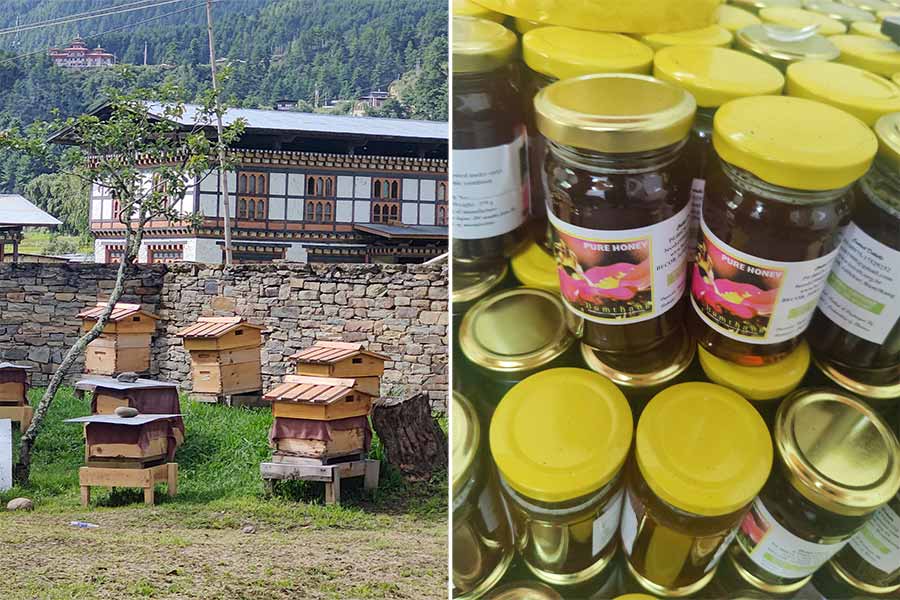
Bumthang, which is one of the leading honey-producing regions of Bhutan, and the (left) Amankora lodge also had its own bee houses
Bhutan has about six different species of honeybees and Bumthang, which is one of the leading honey-producing regions of Bhutan, has hundreds of beekeepers. In fact, I found bee houses in Amankora’s compound. I visit the local beekeepers cooperative and understand the process. Local farmers bring moveable frame hives here and they get paid per litre of honey extracted. There are no additives and the pure honey is bottled and sold. “Religious belief was a hurdle initially, as it was believed that extracting honey was a sin. Now thankfully it’s changing,” says Keunzang Wangdi, of the Beekeepers Association.
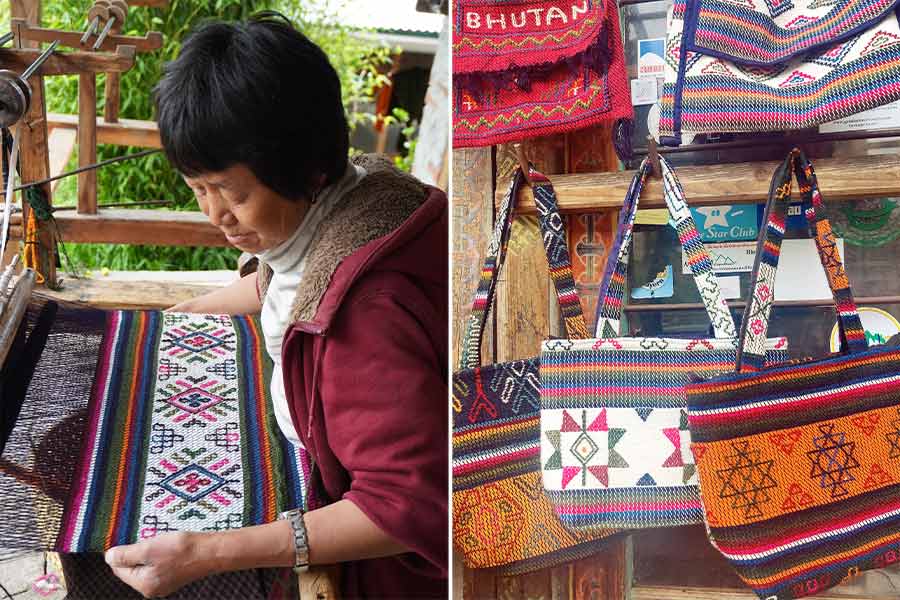
At the Yathra centre, women weave traditional fabric from sheep and yak wool, which are made into rugs, mats, jackets and bags
Along the highway to Chamkhar town in Bumthang, at Chumey, we visit the Yathra workshop to see the bright fabric woven from sheep and yak wool. Women weave the fabric on horizontal frame looms and use organic colours for dyeing the fabric, which is used to make rugs, mats, jackets and bags. “This thick fabric is ideal for the harsh winters in the valley,” explains Sithup.
We also drove into town to visit the state-of-the-art microbrewery of Red Panda, one of Bhutan’s most popular beers. Started by a Swiss cheese maker, Fritz Maurer, who came here in the 1960s on the invitation of the King, Red Panda makes small batches of pale Weiss beer. Next door to the microbrewery is the cheese factory that he helped start, which makes some great gouda and emmental cheese.

The Red Panda microbrewery and (right) the cheesemaking factory
On my last night in Bumthang, I sit by the bonfire, breathing in the cold air at the lodge, as a group of women from a local temple dressed in traditional kiras, perform traditional dances. They stage a welcome dance, a Zhungdra — an ancient folk dance usually performed in monasteries, where the women stand in a single row and dance in slow movements, and they end with a fusion number that has some English lyrics thrown in. I am pulled in to dance along with them, and I get into the flow enjoying my last night in this beautiful corner of Bhutan.
Travel details
- Bumthang is about 270km by road from Bhutan’s capital city Thimphu, and is also connected to the second city Paro by air.
- There are limited airline options to fly into Bhutan, since it needs specialised landing skills. Bhutan’s national carrier, Druk Air, and Bhutan Airlines (or Tashi Air) have international flights to Paro from Kolkata, Mumbai, Delhi, and a few other Indian airports. You can also enter Bhutan by road from Kolkata via Phuentsholing.
- The best time to visit Bumthang is during spring (March to May) and autumn (September to November)
- Indians can travel visa-free to Bhutan, but are required to carry a valid photo ID, preferably a passport. Due to a recent change in rules, Indian tourists also have to pay a Sustainable Development Fee or SDF (Rs 1,200 per day for Indian tourists)
- Bumthang is at a high altitude, so make sure to stay hydrated and take it easy the first couple of days to acclimatise.

